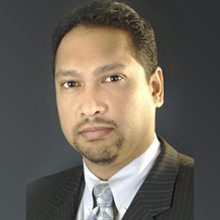
Sanjay Sardar is vice president of modernization and digital transformation at SAIC, a role he’s been in for about seven months. Prior to that, he served as SAIC’s vice president of advanced analytics and simulation. He joined the company from the Federal Energy Regulation Commission, where he served as the chief information officer.
Why Watch: Sardar keeps a close watch on the AI and data market, following the trends and how they intersect with modernization efforts within the federal government.
When it comes to artificial intelligence, Sanjay Sardar sees incredible potential in being able to build insights and prescriptive analysis from what’s been already done in the space. Although in a nascent stage in the federal space, Sardar said AI is going to pick up speed and become more leveraged over the next few years.
“As compute power continues to increase, we are going to see much more interesting use cases applying AI and machine learning within the federal government,” he said. “We’re already seeing adoption of GPUs for parallel processing of the massive amounts of data and the evolution of different architectures in the high-performance computing market.”
Where he expects near-term AI to play a powerful role in is making intelligent predictions and automating nonrepetitive processing in specific problem domains.
“We love the fact that government is exploring artificial intelligence to better drive mission results and efficiency,” he said. “SAIC is investing in research in the practical applications of big data, machine learning and AI, and continues to grow our capabilities in this space.”
AI though, however buzzed-about these days, is a maturing technology and adoption in the federal government is still limited. Sardar says use cases involving machine vision analysis, natural language processing, cyber threat mitigation and responses based on sentiment analysis will quickly start to mature and add real value to the mission.
As for the headlines about AI bias, Sardar says it’s a real concern — and a hard problem for AI technologists to solve.
“It is very difficult to take bias out the system,” he says. “The industry is still exploring AI technology and maturing its usage.” So, for the AI practitioners, “it’s crucial that there is transparency and traceability in the AI decision-making,” Sardar said.
AI, however, should not be seen as a replacement to humans; instead, it should augment the work humans do, Sardar said.
“It doesn’t obviate the need for a human analyst but should be used as a supplement to the human decision-making,” he said.
As for the humans working with AI, how should they be best prepared to maximize the use of AI? Modernization is playing a major role in the exploration and adoption of these new types of technologies, but the focus shouldn’t be just on IT.
“It’s not just about technology modernization,” Sardar said. “It’s also about modernizing the workforce to accept and use these new technologies to make data-driven decisions.”
With workforce modernization, Sardar said there’s a big re-skilling component. With the government customers SAIC serves, Sardar said one of the first things to look at is the impact of technology modernization on the workforce.
“We bring in organizational change management and training, and we start looking at how the business process are impacted,” he said. “That leads us down the path of thinking about what are the skills that the next generation of workforce should have. In every modernization project, including use of AI, it’s important to focus on how to implement the organizational change components, the training components and reskill workers so they can better consume and process data to perform more effectively and discover new ways to advance the mission.”
Sardar concluded: “Modernization can be complex. While we should continue to gain benefits from the infusion of technologies such as AI, we have to also really understand the challenges and impacts, and prepare to deal with them as early as feasible. Only by keeping an unrelenting focus on the mission needs can we appropriately disrupt today to simplify tomorrow.”
Click here to see the full list of Top 10 AI Execs to Watch.

